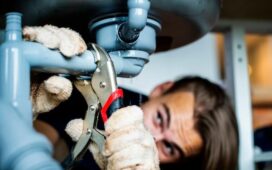Seventy-one million people in the US use natural gas. Unfortunately, more than 430 people die from accidental gas poisoning in the US every year. The main problem is that many people don’t know the signs of a gas leak, and when they do, it may be too late.
People can avoid the dangers of a gas leak with a proper gas inspection. Today we will look at the causes, common symptoms, and what you can do if there are signs of a gas leak in your residence.
What Causes a Gas Leak?
The causes of gas leaks can vary, but the most common ones are household devices, inadequate ventilation, and pipeline corrosion. Let’s go over each one in a little more detail.
Household Devices
It is not unusual for a pipe to become unattached between a gas line and an appliance. This is particularly true if the device is old or worn out. That is why experts recommend changing devices that use gas at least every few years.
Inadequate Ventilation
Gas appliances use fans to remove harmful carbon monoxide that is produced during the heating process. So if your devices are working correctly, this unscented and transparent gas will be distributed by a fan and pipe to the outdoor air.
A defective fan will cause the carbon monoxide to remain in your home, leading to serious health hazards. As you can imagine, a faulty fan is one of the leading causes of gas leaks, as detecting a damaged fan can be challenging.
Pipeline Corrosion
Pipes will begin to erode over time, and sometimes tree roots may crack them, and when that happens, a gas leak may form. It’s difficult to know if your outside pipes are damaged since they are underneath your home and may be difficult to access. That’s why you should contact a certified plumber to perform a gas inspection.
You can check the indoor pipes for a leak using a teaspoon of concentrated dish detergent with one cup of water. Use it anywhere you suspect a leak and look for bubbles to form that indicate escaping gas.
Now let’s discuss the signs of a gas leak in detail.
Signs of a Gas Leak in Your Home
Many people use natural gas for heat, hot water, and home devices. The problem with natural gas is that it has no odor, making it very difficult to know if it’s leaking. Thankfully, gas companies add a safe chemical called mercaptan to natural gas.
Mercaptan acts as an indicator of a home gas leak. The downside of mercaptan is that it smells like sulfur or rotten eggs. Of course, if the gas leak is minor, you won’t smell anything. What other signs of a gas leak are there?
Dead Grass & Plants
Usually, many gas line pipes are running underneath your property, and if one of the pipes crack, then your plants are the first to show symptoms. If you notice that your grass or plants are beginning to wither or turn yellow, then you may have a gas leak. Your plants or grass begins to die because the gas starts to absorb the oxygen they need.
If you notice this, immediately contact a plumber to perform a gas inspection.
Sick Houseplants
Similarly, like the outside plants, houseplants will begin to wither or turn yellow. But they usually need prolonged exposure to gas before they show gas leak symptoms. As you can guess, if houseplants start to die, then the leak is severe.
Bubbly Water
If you have gas heated water, then you may also see signs of a gas leak. The clear indicator is a white cloud or bubbles in standing water, which is another reason to have a gas inspection.
Discolored Flames
A gas furnace has a hot blue flame if it’s functioning correctly. A yellow flame may mean a ventilation issue with your appliance. If your ventilation is malfunctioning, then you may have a gas leak.
Health Issues
If the home gas leak is serious, then health issues will begin to show. The gas leak will reduce the amount of oxygen available, and as you breathe in less oxygen, you may start to develop symptoms.
Here are the symptoms you should watch out for:
- Headache
- Fatigue
- Nausea
- Dizziness
- Eye and throat soreness
- Pale skin or blisters
- Breathing difficulties
Once you notice several of these symptoms and have seen other signs like dying plants or bubbly water, evacuate your home. Then contact a plumber to perform a thorough gas inspection in the interior and exterior of your home.
Children are especially at risk of developing life-threatening symptoms due to exposure to natural gas. Young kids take breaths more often as opposed to adults. As a consequence, your child may present harmful signs of gas poisoning before you do.
What to Do if You See Signs of a Gas Leak
It would be best to open up windows for mild gas odor. Then make sure the pilot light is off and shut off the gas meter, if you know how to. Contact a plumber or your gas company to have them perform a gas inspection.
For a strong gas odor, exit your home or move away from the area immediately. Gas is volatile, and if the leak is severe, there is a high risk of explosion. Make sure to contact your gas provider’s emergency service, but do it far away from the affected area. Phones can ignite gas if there is a spark.
If you have gas leak symptoms, contact emergency service, or head to the nearest hospital for treatment. Even if you have minor symptoms, you should get medical attention.
Act Quickly at the First Sign of a Gas Leak
As soon as you discern the signs of a gas leak, contact a plumber. The longer you or those around you are exposed to the gas, the worse it will be. If you want to avoid any gas leak problems, be sure to have it checked every few months.
If you found this information useful, then be sure to check our other articles. We have many informative posts about home care that will, without a doubt, pique your interest.












